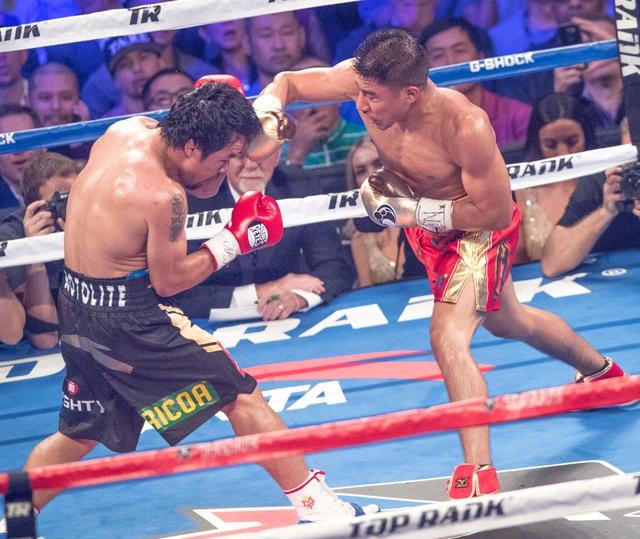Tune in tomorrow …

Actor Leslie Uggams remembers how the televised version of “Roots” took hold in American culture during its original broadcast in 1977.
Uggams played Kizzy, the daughter of an African slave whose family was the subject the miniseries based on a novel by Alex Haley.
She witnessed how the miniseries touched every corner of America, including Las Vegas where she was performing during the original broadcast.
“The casinos were empty,” Uggams said Monday when she spoke to an audience at the National Association of Broadcasters convention. “People weren’t gambling. They were watching television.”
The audience at the Las Vegas Hilton, which included hundreds of the approximately 100,000 broadcasters, content producers and production equipment manufacturers, was clearly moved by clips from the series and a tribute to David Wolper, whose production company made the film.
“‘Roots,’ for black people, is huge because it lays the foundation for belonging,” said actor LeVar Burton, whose character, Kunte Kinte, was at the center of the story.
Just moments after the group pondered how broadcast television had the power to educate America about the epic story of black history in America they were reminded the power is now diluted by countless new niche-oriented media that chip away at its old audience.
Network television rarely provides the singular, mass, national audience who watched “Roots,” the opening of the 1984 Olympic Games and other major moments in American culture.
“‘Roots’ will not be in a major broadcast, it’s just how it is these days,” Burton said.
But that doesn’t mean the broadcast industry will quietly fade to black.
The same digital technology that allows almost anyone to produce and distribute content on the Internet will make television production and distribution cheaper and faster, David Rehr, president and CEO of the National Association of Broadcasters and other speakers told audiences at the conference.
Rehr said it was time for the broadcast industry to regain some of the ground its lost to other media. Rehr said maintaining a foothold with modern audiences starts with how broadcasters think of themselves.
He urged them to adopt new language to describe their challenges. New, forward-looking language will allow the industry to make itself more appealing to viewers as well as lawmakers, who play a big role in regulating disputes that define the playing field for competition between broadcast, cable and the Internet.
Rehr said by describing their challenges with terms like multicasting, terrestrial radio and downcasting broadcasters were confusing the public with “horseless carriage” terminology. He suggested updating the language of public debate over communication to reflect how consumers perceive information.
“We were wireless before it was hot,” said Rehr. “But we are captives of the language of decades gone by.”
The broadcast industry, however, faces more than just an image problem. Even speakers at the convention said they preferred cable-style subscription and advertising-based business models to airborne broadcasting available for free to consumers.
“I think cable TV is a much better business model than broadcasting,” said Joel Hyatt, CEO of Current TV, a San Francisco-based network that collects and distributes user-generated content. “It is much easier to innovate.”
Current TV is carried in about 30 million households and programming includes footage from concerts and video shot by people who happen to be present when news events unfold. Hyatt displayed current footage from the aftermath of hurricane Katrina and street-level fighting in the Middle East.
Despite the changing competitive landscape, the broadcasting industry is adopting to the digital and Internet age.
“I would argue broadcast television has never been higher quality,” said Dennis Wharton, spokesman for the National Association of Broadcasters. Wharton cited shows like “The Office,” “24” and “60 Minutes.”
“Those shows will stand up in any era,” he said.
And even with all the new choices for consumers, especially with television, viewers still spend half of their viewing time with a broadcast network, Wharton said.
The conference also featured the announcement of a new advertising partnership between Internet search engine Google and Clear Channel Communications, a radio broadcasting company with 110 million listeners.
Also, the industry is upgrading from analog to digital broadcasting equipment. On Feb. 17, 2009, analog broadcasts will cease. Consumers who depend on over-the-air broadcasts will receive the transmissions through a digital signal. New televisions are capable of reading the signal and there is an electronic box that can convert the signal for older, analog televisions.
The new digital channels can hold up to four times the content of analog channels, said Shermaze Ingram, a spokeswoman for the National Association of Broadcasters.
That means a broadcaster with one channel today could essentially transmit four channels in the same amount of airspace, she said.
A local broadcaster could, for example, use the space to provide more content for viewers.
“Some people do 24-hour weather, others do public service announcements, others do music,” she said. “It is not just better clarity.”
The trade show and conference continues through Thursday at the Las Vegas Convention Center. It’s closed to the public.